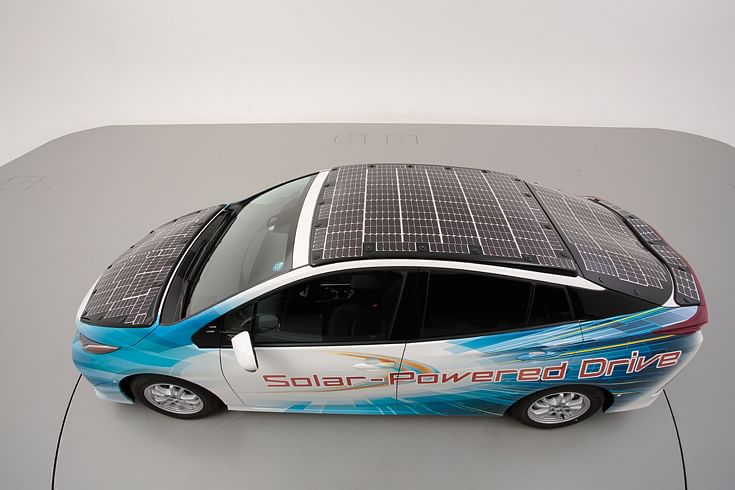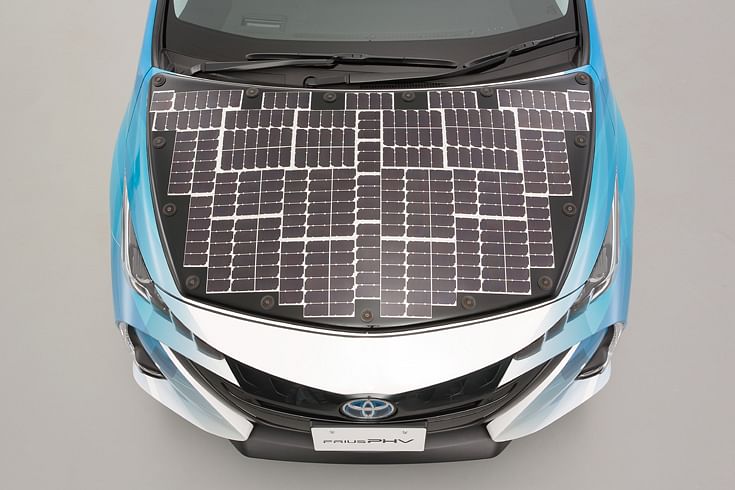Solar battery-powered EV trials to begin in Japan this month
End-July will see NEDO, Sharp and Toyota commence public road trials of electrified vehicles equipped with high-efficiency solar batteries to assess the effectiveness of improvements in cruising range and fuel efficiency.
From end-July 2019, NEDO, Sharp Corporation (Sharp), and Toyota Motor Corporation are to commence public road trials in Japan to assess the effectiveness of improvements in cruising range and fuel efficiency of electrified vehicles equipped with high-efficiency solar batteries.
To facilitate the execution of this trial, Sharp modularised its high-efficiency solar battery cells (conversion efficiency of 34 percent-plus), previously developed for a NEDO-led project, to create an onboard solar battery panel. Toyota installed this panel on the roof, hood, rear hatch door, and other parts of its Prius PHV and produced a demo car for public road trials.


By enhancing the solar battery panel's efficiency and expanding its onboard area, Toyota was able to achieve a rated power generation output of around 860 W, which is approximately 4.8-times higher in comparison with the commercial model Prius PHV (equipped with a solar charging system). In addition to substantially boost its power generation output, the demo car employs a system that charges the driving battery while the vehicle is parked and also while it's being driven, a development that is expected to lead to considerable improvements in electric-powered cruising range and fuel efficiency.
How the demo car stacks up
The demo car is equipped with a solar battery panel that utilises several solar battery cells with a conversion efficiency of 34 percent-plus. The shape of the module, environmental durability, surface materials, and other factors are based on specifications for driving trials implemented by Toyota.

The solar battery cell is a thin film about 0.03 mm in thickness. This makes it possible to efficiently install the film to fit the curves of parts with limited space, including the vehicle roof, hood, and rear hatch door. The rated power generation output of the demo car is approximately 860 W.
Previously, the Prius PHV charged the driving battery only while the vehicle was parked. However, with improvements in power generation output, the demo car employs a system that charges while the vehicle is being driven. This is expected to boost the BEV-mode cruising range and fuel efficiency significantly.
Targeting 1 kW output in EVs
Toyota plans to conduct the trials under various driving conditions in Toyota City, Aichi Prefecture, Tokyo, and other areas. Various data, including the power generation output of the solar battery panel and the amount the drive battery is charged, will be obtained and verified, and then used in the development of an onboard solar recharging system. Toyota plans to share a selection of trial data results with NEDO and Sharp. The ‘Vehicle Strategy Committee’ will evaluate the benefits based on improvements in CO2 emissions reductions and convenience, such as the number of times a vehicle requires recharging. The goal is to contribute to the creation of a new solar battery panel market, including the transport sector, and find solutions for energy and environmental issues.
In April 2016, NEDO, a Japanese R&D organisation, set up the PV-powered Vehicle Strategy Committee, which is comprised of members from industry and academia. With the goal of finding solutions to energy and environmental issues in the transport sector, the committee's research focuses on solar power systems. Sharp and Toyota are also active committee participants.
The achievements the committee has made thus far include estimates on the potential to achieve an output of 1 kW in vehicles, despite the limited space for installing power systems, by using a solar battery module with a conversion efficiency of 30 percent-plus, zero annual recharging depending on usage patterns, and estimated benefits from a reduction in CO2 emissions.
RELATED ARTICLES
Horse Powertrain reveals integrated hybrid powertrain
Unit combines Horse Powertrain’s new 1.8-litre ‘HR18’ engine, its DB45S transmission, a 1.4kWh battery, and 50kW 5DH mot...
BMW Group to use natural fibre composites in its future models
Following several years of development and in-depth research, the BMW Group has reached series maturity of natural fibre...
Nissan reinvents Leaf as a sleek electric SUV with 600km range
First launched as a hatchback in 2010, the third-generation Leaf is unrecognisable compared with its predecessors. The n...





 By Autocar Professional Bureau
By Autocar Professional Bureau
 04 Jul 2019
04 Jul 2019
 7851 Views
7851 Views

















